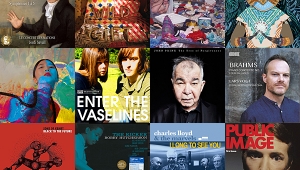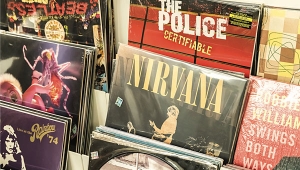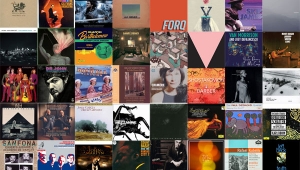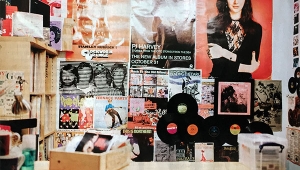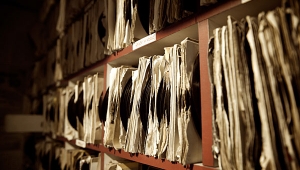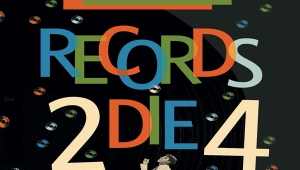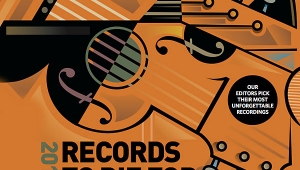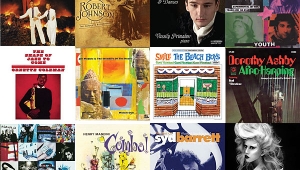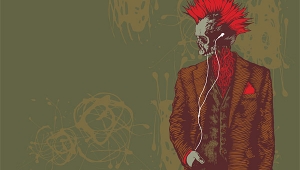| Columns Retired Columns & Blogs |
2007 Records To Die For Page 7
STEPHEN MEJIAS
EDITORS: The Back Room
Fader Label FL-0905-2 (CD). 2005. Jim Abbiss, prod.; Loz Brazil, Cenzo Townshend, engs. TT: 43:42
RODRIGO Y GABRIELA: Live Manchester and Dublin
Rubyworks RWXCD12 (CD). 2004. Rodrigo y Gabriela, prods.; Graham Higgins, Ciaran Hopkins, engs. DDD. TT: 36:56
HOODOO GURUS: Stoneage Romeos
HG/Virtual HG-1 (CD). 1984/2004. Alan Thorne, prod., eng.; Don Bartley, remastering. AAD. TT: 46:28
RON CARTER: Blues Farm
Ron Carter, bass, piccolo bass; Hubert Laws, flute; Richard Tee, Bob James, piano, keyboards; Sam Brown, Gene Bertoncini, electric guitar; Billy Cobham, drums; Ralph McDonald, percussion
Epic/Legacy//CTI 5127862 (CD). 1973/2003. Creed Taylor, prod.; Rudy Van Gelder, eng. AAD. TT: 36:35
EDITORS: The Back Room
Fader Label FL-0905-2 (CD). 2005. Jim Abbiss, prod.; Loz Brazil, Cenzo Townshend, engs. TT: 43:42
If you want to know why I really love this album, it's because it was the first gift given to me by my sweetheart. The woman's got good taste. If that's not reason enough, then you should know that every track on The Back Room is a dark, beautiful hit. Deceptively simple songs are built around hypnotic and infectious bass lines, while reverb-drenched guitar riffs, syncopated drum rhythms, and layers of breathy, passionate vocals intersect at moments of blissful tension.
There is both power and beauty present here; the band just as naturally rouses strongly flying fists as it does softly swaying hips. "Bullets," for instance, with its grandiose chorus of screaming guitars and cymbal crashes, is an undeniable success, while "Camera," with softly-strummed chords and lulling, repetitive hi-hat rolls, is a lingering dream. "If we run, they'll look in the back room / Where we hide all our feelings," chants singer Tom Smith. Editors' The Back Room is a complete album and a wonderful gift.
TV ON THE RADIO: Return to Cookie Mountain
4AD/Interscope CAD 2607 (CD). 2006. David Sitek, prod.; Chris Moore, eng. AAD? TT: 55:31
Return to Cookie Mountain, TV On The Radio's sophomore effort is, by far, my favorite album of the year. If I wanted to be bold and silly about it, I'd say Return to Cookie Mountain is, by far, the very best album of the year. Period. And if I wanted to go even further, I'd say that TV On The Radio is the most important band in rock'n'roll right now. Exclamation mark.
This is an odd and unsettling, droning and magical mess of avant-pop, noise, punk, doo-wop, hip-hop, and soul that not only rewards its listener, but completely mystifies. Mystifies! Despite the experimentalism here – songs feature dense layers of distortion, sitars and synthesizers, violin and cello and clarinet, samples and saxophones accompanied by lyrics about werewolves, love, and war—TV On The Radio has somehow created an addictive and vital pop album. If all this sounds like a crapload of reviewer hyperbole, then please just listen for yourself.
PAUL MESSENGER
RODRIGO Y GABRIELA: Live Manchester and Dublin
Rubyworks RWXCD12 (CD). 2004. Rodrigo y Gabriela, prods.; Graham Higgins, Ciaran Hopkins, engs. DDD. TT: 36:56
File under Jazz. No, make that Heavy Metal. Or perhaps even Folk. Rodrigo y Gabriela come from Mexico City, where Rodrigo was in a heavy-metal band that used to practice in Gabriela's mother's house. The pair started playing acoustic instruments together and traveled to Europe, where they busked, jammed, and eventually broke through into the festival-and-concert circuit.
I love live recordings, even those recorded on MiniDisc players, as this one was (!)—the complete absence of any onstage or studio signal processing gives this disc brilliant realism and dramatic dynamics. The two play their acoustic guitars with great communication, verve, expression, and enthusiasm, liberally using the guitar bodies to add percussion. Of the eight tracks—mostly compositions by themselves or Metallica—the four from Manchester feature just the two guitars; the Irish concert adds violins and voices for some welcome variety.
NITIN SAWHNEY: Beyond Skin
Outcaste CASTE9CD (CD). 1999. Nitin Sawhney, prod., eng.; Tony Ekononmedes, eng. DDD. TT: 58:28
Though born in Britain, Nitin Sawhney is spiritually and ancestrally from India, and fuses the two cultural influences together in an utterly magical way to create a unique blend of trip-hop/drums'n'bass electronic pop interleaved with classic Indian forms, voices, and instruments. Beyond Skin is the middle of his seven albums, and the best in my limited experience, in terms of both music and its superb recording quality. The album is bound together by the theme of an atomic bomb; each track has a short intro, mostly captured from radio newscasts. The intros can become tedious after repeated hearings, but in every other respect this is a splendid album. The elaborate and complex instrumentation is underpinned by sensationally powerful and imaginative bass lines, yet also includes strings, tablas, and decidedly Indian voices in a richly seductive tapestry.
FRED MILLS
HOODOO GURUS: Stoneage Romeos
HG/Virtual HG-1 (CD). 1984/2004. Alan Thorne, prod., eng.; Don Bartley, remastering. AAD. TT: 46:28
Still hailed as one the great debut platters from the Australian alt-rock explosion of the 1970s–80s, Stoneage Romeos (1984) was also a commercial hit, both in its native Oz and Stateside. It's not hard to hear why: the jangly "I Want You Back" sizzles with classic relationship angst; the boisterous "(Let's All) Turn On" is frat/garage rock run joyously amok; and the glam/tribal "Leilani" updates Gary Glitter's "Rock and Roll (Part 2)" arena-chant template for the college radio crowd. Recently remastered and expanded with three bonus tracks, Romeos, in all its trash-culture, reverb- and echo-soaked glory, is still aglow with a speaker-caressing analog warmth no amount of digital rejiggering can shroud.
THE SCIENTISTS: Absolute
Sub Pop SP-106b (CD). 1991. Chris Logan, Peter Watts, Paul Delnoy, Richard Mazda, Scientists, prods. and engs. AAD. TT: 62:01
"In my heart, there's a place called Swampland / Nine parts water, one part sand," moans vocalist Kim Salmon in this Perth, Australia, band's "Swampland," a fetid number that sucks the listener into a sonic bayou backwater while tipping a snakeskin hat to John Fogerty, Tony Joe White, the Stooges, and T. Rex. Grunge label Sub Pop caught a whiff and assembled this 16-song, 1982–86 overview, which spotlights such gems as "Set It On Fire" (Link Wray meets Suicide) and an actual Fogerty cover, "It Came Out of the Sky," ablaze with a fuzz/distortion sci-fi twang its composer never imagined. Nowadays the Scientists go overlooked, but their noxious skronk-blooze lives on in the still-extant Mudhoney and Jon Spencer Blues Explosion.
DAN OUELLETTE
RON CARTER: Blues Farm
Ron Carter, bass, piccolo bass; Hubert Laws, flute; Richard Tee, Bob James, piano, keyboards; Sam Brown, Gene Bertoncini, electric guitar; Billy Cobham, drums; Ralph McDonald, percussion
Epic/Legacy//CTI 5127862 (CD). 1973/2003. Creed Taylor, prod.; Rudy Van Gelder, eng. AAD. TT: 36:35
A couple of years after he left Miles Davis' employ, when the trumpeter's classic jazz quintet of the 1960s had run its course, bassist Ron Carter signed on to producer Creed Taylor's CTI label, where he essentially became the low-end anchor of electric sessions by the likes of Freddie Hubbard and Stanley Turrentine. Three years into his CTI association, Carter recorded his label debut as a leader. That largely electric session, Blues Farm, serves as a masterwork of how the jazz bass can not only undergird but soar as a frontline instrument. On the funky title track, Carter's fat grooves and bluesy glissando lines on acoustic bass sound as if he's playing electric as he takes the lyrical lead, then converses with flutist Hubert Laws. Carter places himself in a variety of settings in which his bass takes prominence, including: his sublime slow composition, "A Soul Ballad," with pianist Bob James and drummer Billy Cobham; the churchy "A Hymn for Him," teeming with bass soul and Laws' floating flute lines; and the festive finale, the Latin-flavored "R2 M1."
STEPHEN STILLS: Manassas
Atlantic 82808-2 (2 CDs). 1972/1995. Stephen Stills, Chris Hillman, Dallas Taylor, prods.; Ronnie Albert, Howard Albert, engs. AAD. TT: 72:00
While Stephen Stills was basking in the glow of his heroics in the early-'70s supergroup Crosby, Stills, Nash & Young, he, like everyone else in the band, was pursuing his own projects. Manassas, originally released on two LPs and receiving little notice compared to CSN&Y, captures Stills at his creative apex, fronting an accomplished session band that included ex-Byrd Chris Hillman and that nails the country-rock essence of the leader's 21 songs. What makes this set so remarkable is that Stills & Co. mix it up unlike any pop band of the era (and few since), infusing the proceedings with Afro-Cuban rhythms (the jazz-inflected "Cuban Bluegrass," set aflame by Joe Lala's percussion), bluegrass (the fiddle- and mandolin-charged "Fallen Eagle"), country gospel (the sober "Jesus Gave Love Away for Free"), and swampy electric blues ("Jet Set"). While the best of CSN&Y sounds dated from overexposure, Manassas today sounds as fresh as it did when it first arrived.
- Log in or register to post comments

